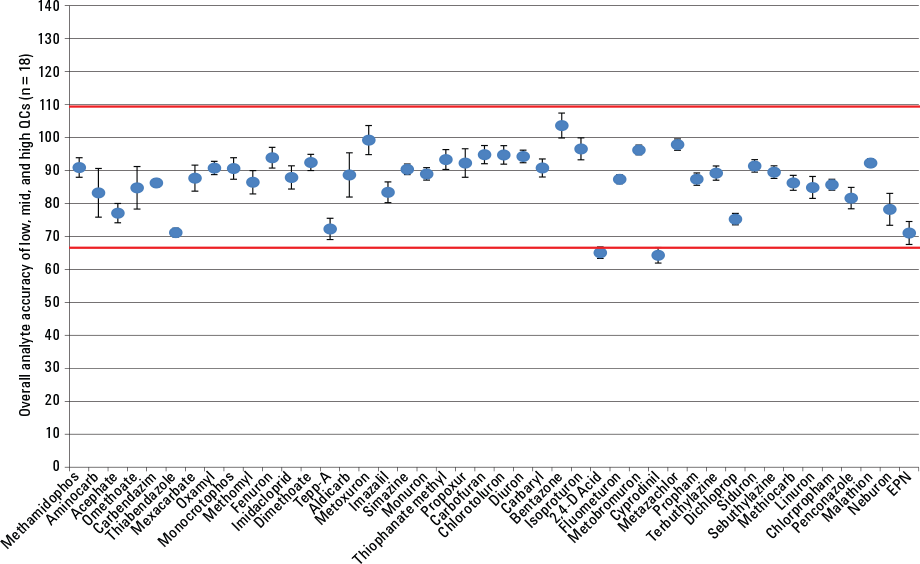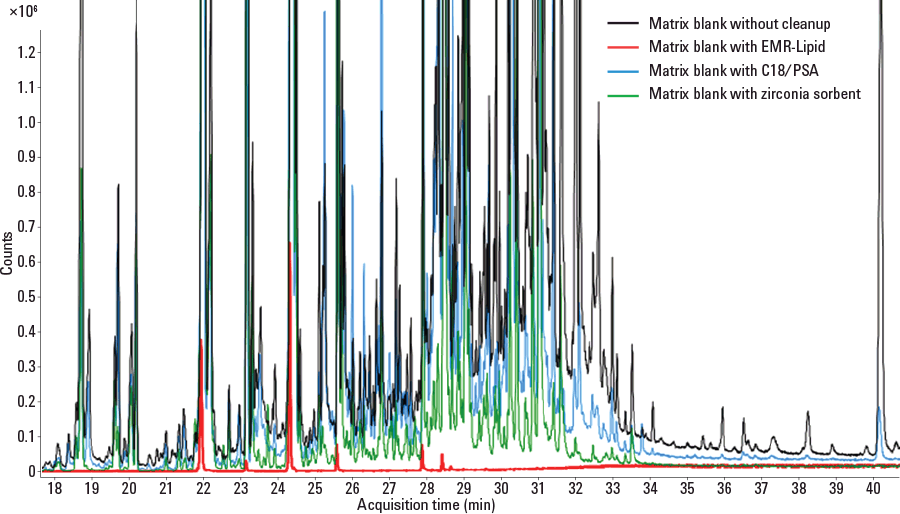Access Agilent eNewsletter October 2015
>> Update My Profile | Subscribe to Access Agilent | Article Directory

Fight the fat with innovative sample preparation solution from Agilent
By April DeAtley
Agilent Sample Preparation Product Manager
Limian Zhao
Agilent Sample Preparation Applications
Interference from lipids is a problem for labs measuring trace residues in fatty foods or complex biological matrices. Lipids can build up in the instrument and column, decreasing lifetime and reducing analyte sensitivity and selectivity due to matrix interferences and ion suppression.
Although the need for lipid removal is understood, current methods often sacrifice analyte recovery by removing targeted analytes along with the lipids. Now, you don’t have to choose between lipid removal and analyte recovery, because innovative Agilent Bond Elut Enhanced Matrix Removal-Lipid (EMR-Lipid) delivers the most complete lipid removal and analyte recovery of any sample prep product.
EMR-Lipid is a unique sorbent that selectively removes lipids in complex and challenging high-fat samples matrices. The material is highly discriminating towards matrix coextractives, especially from fatty samples, without negatively impacting analyte recovery. What’s more, Agilent Bond Elut EMR-Lipid delivers cleaner sample profiles and reduces the need for sample-related troubleshooting. Cleaner samples mean less instrument maintenance needs and downtime, improved cost-savings, and increased lab productivity.
Eliminate analyte loss during sample runs with EMR-Lipid
Efficiently removing lipids from samples without losing analytes is the key to improving chromatographic performance for the best quality data, especially with high-sensitivity MS detectors. The EMR-Lipid protocol considerably improves accuracy, reproducibility, precision, and low-level quantitation when using LC/MS and GC/MS. EMR-Lipid also reduces the amount of matrix entering the MS, with a corresponding reduction in maintenance. This is especially valuable for labs running routine ‘high-matrix’ samples. These advantages are evident when dealing with multiclass, multiresidue applications that are becoming increasingly popular in regulatory monitoring programs.
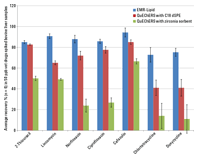 Enlarge
Enlarge
Figure 1. Selected analyte recovery results to compare the Agilent Bond Elut Enhanced Matrix Removal-Lipid protocol with traditional protocols.
Easily extract veterinary drugs from liver
We compared an optimized Agilent Bond Elut EMR-Lipid method with traditional QuEChERS methods that used C18/PSA dSPE and zirconia sorbent cleanup. Figure 1 shows the comparison for selected, problematic vet drugs extracted from bovine liver. The optimized EMR-Lipid protocol provided significant improvements in recovery and precision of the problematic analytes, especially compared to zirconia sorbent. Almost all analytes (93%) had 70 to120% recoveries when using EMR-Lipid. However, only 80 and 55% of analytes had 70 to120% recoveries when using the conventional QuEChERS and zirconia protocols, respectively. Zirconia gave low recoveries for fluoroquinolone and tetracycline classes. The outcomes achieved using Agilent Bond Elut EMR-Lipid are notably superior to results from dSPE with C18 and zirconia.
The Agilent LC/MS system configuration used in this example comprised a Agilent 1290 Infinity II LC , 6490 Triple Quadrupole LC/MS, and Poroshell 120 EC-C18 column. Full details are available in Agilent Application Note 5991-6096EN.
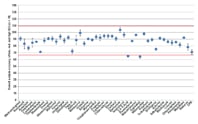 Enlarge
Enlarge
Figure 2. % Recovery results for 44 representative pesticides in avocado using the Agilent Bond Elut EMR-Lipid workflow. Accuracy and precision data were calculated based on 18 total replicates at three different concentrations.
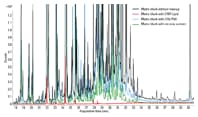 Enlarge
Enlarge
Figure 3. GC/MS full-scan chromatogram overlay of avocado matrix blanks prepared by a QuEChERS AOAC extraction followed by dSPE using Agilent Bond Elut Enhanced Matrix-Lipid (red), zirconia (green), PSA/C18 (blue), or no cleanup (black).
Excellent reproducibility for LC/MS pesticide analysis
Avocado is another high-fat matrix that presents difficulties during extraction. However, with Agilent Bond Elut EMR-Lipid we extracted 44 pesticides from avocado before analysis by LC/MS (Figure 2). Accuracy results showed that 95% of the 44 pesticides fell within the 70 to 120% window, except for 2,4-D acid and cyprodinil, which gave recoveries just below 70% with good RSD. The method reproducibility was exceptional with less than 10% RSD (n = 6) for 91% of the pesticides at 5 ng/g, 100% at 50 ng/g, and 98% at 200 ng/g.
For this analysis, the same Agilent LC/MS system was used except for the column, which in this case was a ZORBAX RRHD Eclipse Plus C18. Read the full details in Agilent application note 5991-6098EN.
Better instrument performance for GC/MS pesticide analysis
Agilent Bond Elut EMR-Lipid, is equally effective before GC/MS analysis. For this example, we used an Agilent GC system with an Agilent 7890 GC, Agilent 7000C Triple Quadrupole GC/MS, and Agilent J&W DB-5ms Ultra Inert column. Figure 3 shows overlaid GC/MS full-scan chromatograms for an avocado matrix blank and the chromatographic profiles obtained with Agilent Bond Elut EMR-Lipid, C18/PSA, and zirconia cleanup. The chromatogram from the sample without further cleanup (black trace) shows a high abundance of matrix interferences, which will hinder the analysis of target analytes. The chromatograms from extracts treated with C18/PSA (blue) and zirconia sorbent (green) show 36 and 55 % removal, respectively. However, the EMR-Lipid dSPE trace (red) shows near baseline removal of these interferences, corresponding to 95% matrix removal.
The large amount of cleanup achieved with Agilent Bond Elut EMR-Lipid has obvious implications for the analysis of pesticides in avocado as there is dramatically less matrix in the sample to affect instrument performance. Furthermore, extraction is achieved using a simple dSPE procedure with EMR-Lipid in a conventional QuEChERS workflow.
Superior sample prep with Agilent
These investigations demonstrate the superior cleanliness that can be achieved using Agilent Bond Elut EMR-Lipid as a dSPE sorbent. This solution is just one of many innovative Agilent sample prep products designed to speed up your workflows. Take a moment to explore the whole family of solutions today.
>> Update My Profile | Subscribe to Access Agilent | Article Directory
Figure 1.
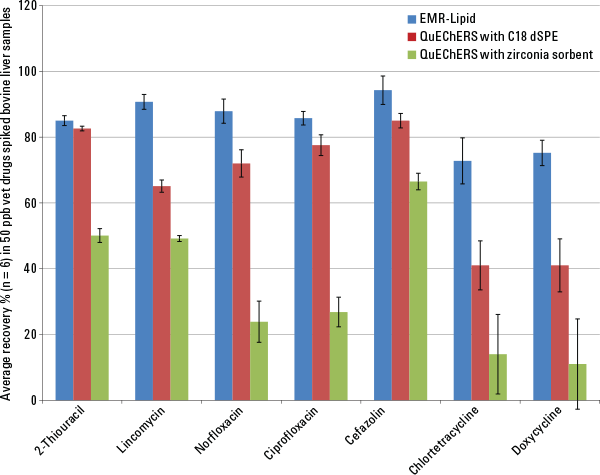
Selected analyte recovery results to compare the Agilent Bond Elut Enhanced Matrix Removal-Lipid protocol with traditional protocols.
